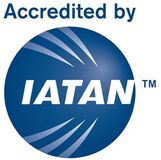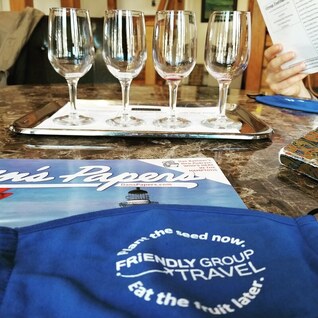 by Marcia Simon By industry standards, the North Fork of Long Island is still in its winemaking infancy. The region's viticulture reputation has been steadily on the rise since 1973 when its first commercial grape vines were planted. The region now boasts about 55 wineries and vineyards. Unlike Connecticut, where driving takes all day to follow the wine trail from Stonington to Litchfield, a 25-mile span along eastern Long island's north coast allows for easy stops for tastings, picnicking and musical entertainment in season. During a COVID-winter, the scene is surely different and very quiet mid-week, which is attractive to people more interested in the wines themselves. It's a quick getaway that is as COVID-safe as you make it. The North Fork is as laid back as Long Island gets. Its popularity as a destination is growing as the quality of its wines and oysters are added to restaurant menus across the country. This unpretentious east end of Long Island is less than 100 miles from New York City, and less than 90 minutes with a car on the Cross Sound Ferry from New London to Orient Point. The water, air and soil trifecta Surrounded by Long Island Sound, the Peconic Bay and salt water from the Atlantic Ocean, the North Fork is buffered from both warm and cold fronts. This unique climate protects grapes through a long growing season and gives winemakers more control over their harvests; they can pick their fruits at peak times for ripeness. The region's most popular varietals include Bordeaux-style reds – Cabernet Franc, Cabernet Sauvignon, Merlot and Malbec from which winemakers create their signature blends. Sauvignon Blanc and Chardonnay are popular whites, but even more inviting than a soft white is a glass of North Fork Rosé or Gewürztraminer, which many think of as sweet wines, but after tasting a few, it's safe to say that many are refreshingly light and dry. My two travel companions and I enjoyed tasting flights at multiple vineyards during a January road trip along Routes 25 and 48 between the towns of Peconic and Jamesport. We visited the grounds of several others, too to get a feel for their upcoming in-season outdoor scene and COVID-safety. Featured Vineyards Starting at Pellegrini Vineyards in Cutchogue, we were the only tasters at 12 noon. We tried four varietals and surprisingly preferred the easy-drinking, dry 2019 Rosé. Pellegrini's tasting room mixes old world charm with modern open space and technology. Guests are welcome to walk over to the adjacent building to view the stainless steel fermentation tanks, behind glass walls, used in the winemaking process. Pellegrini's winemaker is Zander Hargrave, son of Alex and Louisa Hargrave who were pioneers of the North Fork wine industry with their vines back in 1973. The largest of all the Long Island vineyards is Pindar Vineyards in Peconic, This family owned-and-operated vineyard is run by siblings Pindar, Alexander and Alethea Damianos. A fourth sibling, Jason, was an integral part of the family operation, too, and later opened Jason's Vineyard in Jamesport. An unfortunate car accident took Jason's life in 2015, and the Damianos family now operates Jason's as well as Duck Walk in Southold, which their father acquired in 1994. Remembering a blueberry port wine I tasted years ago at Duck Walk Vineyards, my travel companions and I stopped in to try it again. We also tried their Boysenberry Fruit Wine, which is not a port, but a very tasty after-meal sipper. The family patriarch, Dr. Herodotus Damianos, known as Dr. Dan, was an internal medicine physician by profession when his winemaking vision led him to purchase 36 acres of potato farmland in 1979 on which he planted his first Chardonnay grapes from California vines. Today, Pindar's 500 acres yield 17 varieties of grapes and more than 70,000 cases of wine every year. As large as it is, Pindar Vineyards' comfortable atmosphere provides a warm environment for tasting their popular reds such as Cabernet Franc, Pythagoras. We particularly enjoyed their Cabernet Sauvignon Reserve and Cabernet port. Pindar is among the pioneering vineyards of the North Fork sustainable wine movement away from chemical fertilizers and pesticides. Their massive composting operation combines lawn clippings from dozens of local landscapers, fish parts from a local seafood wholesaler, and their own grape skins. Tons of this rich organic compost is spread over the vineyard's sandy soil to enrich the grapes. COVID-19 Precautions Although some Vineyards are closed for winter, or operate on limited hours during the pandemic, the wineries we visited all took their safety precautions very seriously. Some offer tastings by reservation only; others accept drop ins, with occupancy limits. Mid-week in January, the tasting rooms were practically, and sometimes literally, empty; we felt very COVID-safe the entire time. Visitor traffic picks up on weekends, we were told, so mid-week is advantageous. Masks are required everywhere to keep staff and visitors safe. Travelers who want to venture out with their bubble (up to six people) before the crowds return for spring season can rent one of the Bergen Road Bungalows at Macari Vineyards. These private, cozy heated tents provide your group with four hours of relaxed tastings from the selection of flagship Macari wines paired with a locally prepared gourmet lunch overlooking the grape vines on this 180-acre vineyard. An Overnight Delight After tasting wines at four vineyards, we were ready to check in to the Sound View Hotel in Greenport, three miles west of the village, and a short ride from most vineyards. Arriving before sunset, we watched the sky's changing colors from the deck of our room. If you didn't know its story, you'd drive by Sound View, thinking this is still a 50s-era roadside motel. Now owned by Eagle Point Hotel Partners, renovations began a few years ago and are ongoing. Simple, rustic and modern all at the same time, this hotel feels beachy and upscale at the same time. All rooms provide waterfront views of Long Island Sound. It's so close to the water that you might get sea spray on your windows during a storm. The hotel's Halyard Restaurant had limited winter pandemic hours. However, the to-go menu includes plenty of tempting items available for room delivery. From chowder to chili, turkey-bacon wraps to fish and chips, local sea scallops, salads and a kids' menu. That night we were able to decipher the beacon patterns from Old Saybrook breakwater and the red blinking light that marks the channel by Duck Island in Westbrook. It's 14 miles across the Sound from this location and the winter wind on the water kept the sky clear across to Connecticut.
From Potatoes to Grapes Long before the first grape vines were planted on the North Fork, its rich fertile soil attracted potato farmers who moved east when suburban sprawl started to take over the land closer to the New York City. In the 1940s, about 80 percent of all farming on Long Island was dedicated to potatoes, according to potatonewstoday.com. Potato farming still exists on the North Fork. In fact, North Fork Potato Chips is a thriving business. Farm stands serve many of the local restaurants with fresh vegetables and fruits and season, and the oyster farms ship nationwide. But it's the grapes that are the North Fork's current attraction from a growing number of visitors. Marcia Simon, CTA, APR, is a Connecticut-based travel writer and advisor. Contact her at welcome@friendlygrouptravel.com, on Instagram at friendlygrouptravel, facebook.com/friendlygrouptravel and Twitter @friendsgotravel.
0 Comments
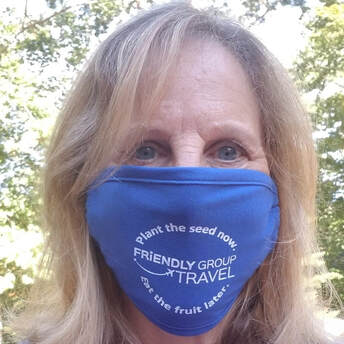 by Marcia Simon, CTA, APR A trip to the supermarket triggers anxiety, but looking at photos of Caribbean beaches and crystal clear blue waters makes me want to hop a plane and wiggle my toes under a pile of warm golden sand. How safe is travel at a time when the COVID-19 pandemic continues to soar? We're all tired of COVID; this is not the time to let down your guard. The question is whether or not it is possible to travel safely. A lot depends on your personal situation, when you want to travel, and how important the trip is. Do you have a compromised immune system due to a medical condition or age? Are you the primary caregiver for a family member? Would you lose needed income if you were unable to work for a month due to illness or quarantine before you could get back to your job? On the other hand, airlines, airports and hotels appear to be taking every precaution to maintain a clean, sterile, safe environment. And not just for travelers; they are equally concerned about the health of their employees. Not all destinations provide the same level of protection. Many hotels have reduced occupancy limits, so expect fewer guests. Along with that, anticipate fewer dining choices at resorts known for numerous culinary experiences. Buffets are gone. Masks are required in all public spaces; guidelines vary at pools and on beaches. And assume that nighttime entertainment will be minimized, too. Don’t expect an early check in. It takes longer to sanitize rooms and deep-clean the areas. Most hotels are not cleaning rooms on a daily basis either, so you'll need to make your own bed and clean up after yourself from check-in to check-out, depending on the length of stay. Ask the hotel before you book what their policy is about room occupancy and cleaning. Destinations outside the US approach entry requirements in different ways. Some mandate proof of a negative COVID test result within 72 hours of arrival. Some require proof of health insurance that covers you while in their country. Rules may change from the time you book your trip and the time you actually travel. Insuring Your Safety Aside from protection against lost luggage, accidents and trip interruptions, "Cancel For Any Reason" insurance is a no-brainer today, whether you're booking a trip for next month or two years from now. But not all policies are the same. Some allow you to cancel up to 24 hours before your trip with 100 percent cash refund. Many resorts now include cancellation insurance at no additional cost, giving you a credit for future travel rather than a clean refund. Some policies exclude medical care due to COVID, so make sure you understand the policy to assure you are actually purchasing what you think you are. Insuring your trip is probably more important now than ever before. So, is it okay to travel? The answer lies in diligence. If you expect to get away so you can escape the coronavirus, forget that thought. It's not possible now. Are you willing to mask up and revise your expectations so you can feel a warm breeze on your back, and close your eyes on a lounger submerged in an infinity pool overlooking the most amazingly blue ocean you've ever seen in your life? Run on the beach? Enjoy a fine wine or ice cold beer with the sound of island music as the sun goes down? Would you be happy eating some meals, delivered by room service, on your oceanfront balcony instead of in a dining room? Hunkering down at home to minimize the risk of leisure travel during a pandemic that can literally kill you makes perfect sense, at least until you've received the two-step vaccine in its entirety. And yet, many people are determined to go and are willing to take the risk if they have already experienced and recovered from COVID-19 and have been shown through testing to carry antibodies, which may offer protection to some degree to themselves if not to others. The waters of COVID are uncharted. Nobody knows anything with certainty. For those who choose to travel by plane during the pandemic, follow these recommendations from Friendly Group Travel in Westbrook, Connecticut to maximize safety: 1. Choose nonstop flights to reduce exposure to people and surfaces at multiple locations. 2. Pay for an assigned seat and choose a window on the left side of the plane, away from the restroom area. Window seats generally expose you to less contact with other passengers. The left side of the plane usually disembarks more quickly than the right. 3. If at all possible, avoid a checked bag and go with carry-on only. Some airlines have tightened requirements for carry-on sizes to reduce the time passengers juggle carry-on luggage in and out of overhead bins. Confirm this beforehand so you can pack accordingly. 4. Use private ground transportation from the airport to your hotel (some hotels include this now at no additional cost) rather than a shared shuttle. 5. Get "Cancel for Any Reason" (CFAR) insurance at the time you book your trip. Your circumstances may change, or you may become less comfortable about travel as the date gets closer. 6. Check your hotel's policies on occupancy limits, how and how often they clean guest rooms, how long they wait to fill a room between guests and whether room service charges are waived if you decide to eat in your room. 7. This is not a time to look for bargain hotels. Prioritize comfort and safety. Many of the larger hotel chains have trusted safety protocols and sanitation standards you can find on their websites.  NOTE - It is perfectly safe to start planning your next trip now. Get ideas, start dreaming, and enjoy your time at home being an armchair traveler preparing your next adventure. Marcia Simon is a Connecticut-based travel writer and a travel advisor. Connect by email welcome@friendlygrouptravel.com or connect via Facebook, Twitter or Instagram. 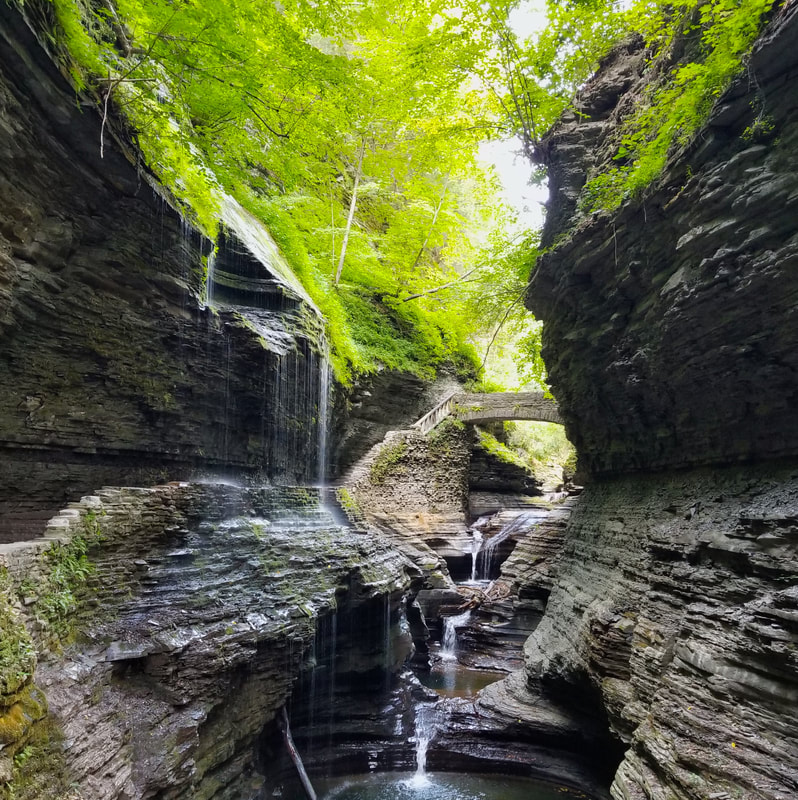 Rainbow Falls at Watkins Glen State Park Rainbow Falls at Watkins Glen State Park by Marcia Simon, CTA, APR Everyone needs a summer break, even during COVID-19. Having seen gorgeous photos of Watkins Glen State Park, it’s been on my hiking bucket list, so we loaded up the car on a Sunday morning and headed to the Finger Lakes. Traveling midweek instead of weekends means fewer crowds, better hotel prices and less traffic on the roads. Our first destination was Mount Morris, NY, where we checked into the Allegiance Bed & Breakfast, a 46-room Greek Revival mansion. Each of eight guest rooms is named for a local historian from the 1800s. The Allegiance B&B itself is named in honor of Francis Bellamy, a neighbor, who wrote the Pledge of Allegiance. Owners Steve and Glenda Luick are transplants from Los Angeles who dreamed of living their retirement years running a B&B where they could enjoy four distinct seasons and lots of country comfort. When they saw the building, they knew instantly that this was their place. What they didn’t know until after they moved in was that their home would ultimately develop a reputation as one of the most haunted houses in the world. The spirits are friendly and make themselves known only occasionally, but never to intentionally frighten anyone. Steve greeted us, wearing his COVID-safe mask, making sure we were wearing ours, and showed us around before taking us up to our room on the second floor. This is a great location for hikers who want to spend a day at Letchworth State Park. The B&B is located one mile from the park’s north entrance. There’s not a whole lot to do in the area, especially during COVID times when so much is closed. That’s okay, though. The B&B oozes laidback elegance, and after a short walk into town for a casual dinner, we found that sipping a glass of wine on the front porch was the perfect way to unwind before heading up for a comfy snooze. Letchworth State Park received the 2015 USA Today Readers’ Choice Award for Best State Park in the United States. It runs about 17 miles from top to bottom on either side of the Genesee River. Aside from the north entrance in Mt. Morris, you can enter the park from the south (Portageville) and west (Castile – the most popular gateway). With 14,000 acres and 66 miles of hiking trails, the Upper and Middle Falls are most popular, and most crowded, so arrive early to enjoy walking while remaining socially distant. The water level in the Genesee River, due to a hot, dry August, was relatively low. I imagine that in spring after the snowmelt, the park’s 30 waterfalls would be magnificent; autumn’s foliage would be simply breathtaking. Letchworth State Park is called the mini Grand Canyon of the East. The Genesee River has created a deep gorge bound on either side by cliffs higher than 500 feet in spots. White water rafting through Adventure Calls Outfitters was closed, possibly due to COVID-19 or possibly the fact that the water level was pretty low. Class 1 and 2 rapids make this a perfect activity for families with children or first-time rafters. You can find overnight accommodations inside the park at the Glen Iris Inn and its affiliated properties, with everything from motel-type cabins to balcony suites overlooking the Middle Falls. Make reservations early because the convenient location attracts tourists. Campsites can be reserved through the park. Letchworth State Park and Watkins Glen State Park both offer free admission this summer, with a modest parking fee for a full day. Both parks prohibit swimming in the gorges, partly due to safety concerns. Hiking is on well-defined trails high above the waterline. However, both parks have big, clean, family-friendly swimming pools. Aside from hiking, farming and incredibly bucolic scenery, the Finger Lakes are known for their vineyards, so off we went to explore the wine trail. Canadaigua Lake may have the most well-known wineries. There’s also a wine trail around Cayuga Lake. We headed for Seneca Lake, which has more wineries, almost 70, than any other lake in NY State. We started at the top in Geneva, with plenty of time to hit up three vineyards along the lake on our way down to the village of Watkins Glen at the bottom. First Stop on the wine trail… Belhurst Castle Winery, Inn and Restaurant (They also produce craft beers) overlooking the lake in Geneva. I was wondering how COVID-safe the tasting would be, but when I walked over to the tasting bar and picked up the menu, I was quickly scolded for not checking in with the host, and reminded that they’d now need to re-sanitize those two seating areas for someone waiting their turn. Oops. OK, no worries. I was happy to see the standard of cleanliness. Second Stop… Keuka Spring Vineyards in Penn Yan, proud to share their unoaked Seyval Chardonnay, Riesling and ice wines. The Finger Lakes are known for sweet whites, although the dry Riesling was quite nice. Jim at the bar was happy to tell us about the ice wine process. He collected our names and phone numbers for contact tracing, “just in case we need to notify you,” he said. That was reassuring. It was clear that extra space had been added to keep tasting parties (of two) distanced from each other. Glenora Wine Cellars in Dundee was next, with a restaurant and modernish accommodations overlooking the lake. We were just about 10 meandering minutes away from our destination – Watkins Glen Harbor Hotel at the bottom of Seneca Lake. If you want to stay on the water, this seems like the only choice for Watkins Glen. Because of the state park, there’s a demand for modest motels and camping. The park has 54 electric and 241 non-electric campsites. A few B&Bs seem interesting. This is the only large hotel with a dock for transient boats and indoor/outdoor waterfront dining. Arriving at Watkins Glen State Park before 8 am the next morning gave us sample time for hiking and photos before the crowds started rolling in around 9:30. For coronavirus safety, the famous Gorge Trail, with 19 waterfalls, is one-way up and then one-way down on the Indian Trail. It’s a good idea. All together it only takes about an hour and a half so we drove the two-minute ride to the other side of the river and hiked the South Rim as well… still getting back to the hotel in time for lunch. (Normally there’s a shuttle that runs between the park’s three entrances, but it’s not operating during COVID-time.) We discovered a small casual restaurant down on the waterfront, the Village Marina, that seems to be a favorite spot for locals. They have sandwiches and salads, plus a full page of local wines by the glass. Two miles from the hotel is Castel Grisch Winery. Their COVID-safe tasting flight is pre-poured, and you take the five samples outside where there’s plenty of space. Filling out contact tracing forms was required. All in all, we packed a lot into a four-night getaway, but it never seemed too busy. Driving around on quiet back roads was a real flashback to less complicated times, and just the break I needed to ease the anxieties of the never-ending coronavirus era. Other places to visit in Watkins Glen: Schooner True Love –for sailing experiences such as Sails & Ales and Wine & Winds on the Water. Unfortunately, they are not operating this summer due to COVID-19, but you can still buy a T-shirt online to show your support. Seneca Cheese Company – for artisan cheese, charcuterie, locally crafted wines and beers Watkins Glen International speedway – “The Glen” is closed for racing this summer due to COVID, but hoping to open to host the October 30 Finger Lakes Beer Festival featuring over 40 New York State breweries, distilleries and cideries. Marcia Simon, CTA, APR, is a travel advisor, travel writer and publicist. She plans small group and independent journeys as owner of Friendly Group Travel. During COVID-19, she shares safety information and updates. Visit friendlygrouptravel.com or connect at facebook.com/friendlygrouptravel Twitter @friendsgotravel Instagram @friendgrouptravel. by Marcia Simon, CTA After five months of diligent self-protection against the coronavirus and pining for travel, it was time to get away, but where?
From the Connecticut shoreline, it’s a two and a half hour drive to Cape Cod, adding another hour for the forty-mile ride to the tip. This is Provincetown, the Mayflower’s first landing in the New World in 1620 (Yes, the Pilgrims stopped here for five weeks before sailing on to Plymouth. Or so it’s told.) P-town, as it’s known, is a welcoming haven for artists and the LGBTQ community. Here you can be yourself and feel free… as long as you wear your face mask. Signs are posted regarding the mandate to wear a face covering on Commercial Street, the main tourist strip lined with restaurants, ice cream shops, t-shirt and souvenir stores… as well as colorful nightlife in “normal” times. As of mid-July, for the most part, bars, night clubs and cabaret shows are closed, although the Crown and Anchor’s popular cabaret show premiered its reopening this month with scaled-down outdoor seating. Numerous art galleries and restaurants are open – with limitations. Curbside take-out is available as well as limited indoor and outdoor dining. Provincetown offers lots of safe-looking restaurant choices that provide ocean views or a clear shot of the activity along Commercial Street. Enjoy patio dining with some of the freshest fish and lobster you’ll find anywhere, or walk up to a take-out stand and grab a comfortable spot on the beach overlooking Mac Millan Public Pier, the meeting place for ferries, fishing boats, and whale-watching tours to Stellwagen National Marine Sanctuary. Provincetown is one of the world’s natural deep water harbors ~ attracting boats of all sizes. Whale watching, fishing and sailboat trips were operating – limited to 50% occupancy as of mid-July 2020. The Pilgrim Monument and Museum, one of the most popular tourist stops offering a magnificent bird’s-eye view – with 116 narrow steps taking you to the top of the tallest all-granite structure in the United States – was closed during my July visit. So was the adjacent Provincetown Museum. Visitor Centers in town and at the National Park were closed as well. However, public restrooms were open and clean. Because the bars are closed, night life fades early, with many restaurant kitchens closed by 9 pm. Phase 3-Step 1 reopening requires no more than six people at a table in restaurants, so large parties and family groups will be split up. To cut back on surface contamination, most restaurants ask you to scan a QR code either at the hostess station or at your table to download the menu to your phone. If your server sees that you’re sadly tech-deficient, you’ll be offered a paper menu, but shared surfaces in general are out. Ketchup, mustard, salt and pepper are served in single portion packets. A Note About Lobster Rolls New Englanders know all about lobster roll preferences. In Connecticut, for instance, a perfect lobster roll is served hot, on a buttered, toasted (or grilled) hot dog bun with a portion of melted butter on the side for dipping. However, in Provincetown, if you don’t specifically ask for a hot lobster roll, you will most likely get a cold lobster salad, very little mayonnaise, and usually with a leaf of lettuce on a hot dog bun. And if you order it hot, there’s a good chance your bun won’t be toasted. Just sayin’. Exploring the coastline Parking in P-town can be tight. Walking lets you meander, and offers lots of opportunities to take photos you might otherwise miss. Bicycling is popular, with ample inventory at the local bike shops in and around the town. Because the terrain is basically flat, cycling is easy, and what’s better than bicycling along a long stretch of coastline? The Cape Cod National Seashore has bike paths ideal for families with young children; these are generally protected by the shade of the forest canopy. The National Seashore is a pristine 40-mile stretch of beautiful sand, dunes and pitch pine forests. We hiked one of the park trails in nearby Wellfleet. The 8.8 mile-loop zig zagged between shady pine-needled forest and sandy beach. While pets are welcome in the park, there are stretches along the beach where the habitat is protected for piping plovers and other endangered species of birds. These are no-pet zones (because dogs tend to scare the birds and disturb their natural environment.) Two tips: 1. While some of the trails run through a shaded forest, parts take you onto the beach, which is gorgeous, but the sand can be very hot on bare feet, and the sun can feel scorching. 2. It’s easy to access Jeremy’s Point and sandbars during low tide, but the tide comes back in quickly, making for a wet walk back. If you can catch a morning low tide, it would be a great time for a summer hike. This area would be magnificent in autumn’s cooler weather. We encountered very few people along the hiking trails and, for the most part, were able to keep our face masks in our pockets. Race Point Beach was uncrowded enough to allow for easy social distancing. Walking from the parking lot to the stretch of beach along the narrow sandy path was a bit more trafficked, so masks are recommended for that, but once you’ve staked out your spot, the mask is not necessary if you are comfortable with the safety of your travel companions. Accessing many hiking trails in the park is free. But if you want to park to access the beach, the fee is $25 per car. We spent a half day at the National Seashore’s Race Point Beach. Umbrellas are highly recommended to protect you from the intense summer sun even when the ocean breeze is blowing. And the water is cold. Very refreshing, but cold. To Go or Not to Go? Assessing Your Personal Risk Whether to venture out or stay home is a personal decision, based on your risk factors, overall health and immune system, others in your household who may be high risk, and how careful you will realistically be with safety, masks, sanitizing and social distancing when you're out and about. Overall, Provincetown seems surprisingly quiet this summer. Even the ride over the Bourne and Sagamore Bridges that cross the Cape Cod Canal from the mainland were delay-free, which is a true rarity. Crowds will likely build through the rest of the summer. Midweek is always less crowded, and lodging less expensive, than weekends. This was a fun 3-night getaway. Just what I needed to renew my energy. I felt safe – because I was very proactive about my personal safety, social distancing, sanitizing, and wearing a mask in public places. Visitors, residents and people who work in the Provincetown community embrace masks. In fact, the souvenir shops have some pretty unique and fun mask designs. (The t-shirts are great, too.) If you are part of the anti-mask culture, do not go to P-town. Stay away. This is a community that is doing its best to stay safe; if you do not support that, you shouldn’t be there. If you love long walks on the beach, early mornings on the water, sunsets over the horizon, lobster and an open-minded, nonjudgmental vibe, go and support the economy of a town that relies heavily on tourism. One waiter, concerned about his own safety while being engaged with customers all evening, summed it up nicely: “Of course we want people to come here. That’s how we make our living. On the other hand, we really don’t want people to come if it increases our risk for coronavirus.” So wear your mask. Bring sanitizer. It’s a matter of your personal safety and respect for people around you – making your getaway enjoyable and safe. For more information about Provincetown and COVID-19 travel updates, visit: https://ptowntourism.com/ https://www.visit-provincetown.com/ https://www.provincetown-ma.gov/1313/COVID-19-Coronavirus-INFORMATION-PAGE Marcia Simon, CTA, APR, is a journalist, publicist and travel advisor who gets around as much as possible, and plans small group and independent journeys as owner of Friendly Group Travel. Connect at facebook.com/friendlygrouptravel, twitter @friendsgotravel and Instagram @friendgrouptravel. 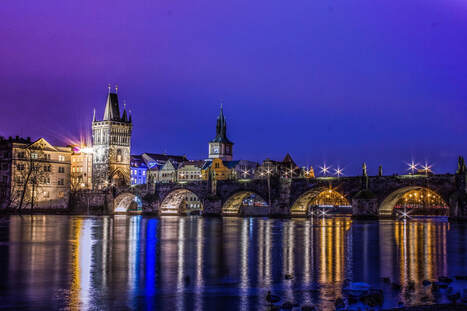 by Marcia Simon, CTA, APR A European river cruise is a bucket list trip for a lot of people and, once hooked, making multiple journeys is quite common. If you’re exploring a river cruise for the first time, there’s a lot of nitty-gritty information that river cruise companies don’t tell you upfront. Working with a travel advisor can save you a lot of time, money and aggravation in the long run. First of all, there is no “one size fits all” best river cruise company. Some are true luxury, which is fabulous for those who can afford it, but are beyond the budget of most people who travel as a lifestyle. Some river cruises cater to older (aka retired) travelers while others direct their activities to active adults and multigenerational families. There’s also at least one river cruise company that designs the ship, cuisine and itineraries for younger (under 40) travelers who want to hang with people in their millennial age range. So, make sure you choose a cruise directed to your personal interests and demographic. 7 Factors to Consider When Exploring a River Cruise Vacation:
The best way to get great deals on river cruises is to take advantage of early bird and last-minute deals, off-season schedules, and bargaining power of travel advisors who work with a consortium that brings high-volume special perks. Travel advisors keep their radar up for what clients want. 7 Great Things About River Cruising:
Marcia Simon, APR, CTA, is a PRSA-accredited public relations practitioner, and an IATA-accredited travel advisor. Connect through facebook.com/friendlygrouptravel, Instagram @friendgrouptravel or welcome@friendlygrouptravel.com. 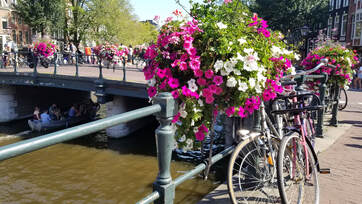 by Marcia Simon, CTA, APR Amsterdam, the capital city in the Netherlands, is known for its canals, bicycle culture and love for the arts. After all, this is home to Van Gogh, Vermeer and Rembrandt. And Heineken. Amsterdam’s tourist season begins in April when tulips generally reach their peak in Holland, which covers two provinces in the Netherlands. Summers are very busy, and August 2020 will be no exception with Sail Amsterdam, a once-every-five-year event that features tall ships from around the world accompanied by street food and entertainment, and also August’s annual 10-day Grachtenfestival for classical music, jazz, and music from other cultures. Off-season, on November 2, 2020 to be exact, the annual Amsterdam Museum Night gives you access to museums city-wide that stay open until 2 am. One wristband gets you in to all 50 participating museums. November also brings the Super-Sonic Jazz Festival to the city. For canal tours, the "best" time is April through October. Summers, of course, are warmest and also the most crowded. No matter what time of year you go, here are 10 Ways to Feel the Groove of Amsterdam, Holland:
Getting to Amsterdam is easy with flights arriving at the city’s Schipol Airport from around the world. A taxi from downtown Amsterdam will cost about 60 euros, while the train from the airport to Centraal Station runs every 10 minutes for 6 euros a ticket. The kiosks to purchase train tickets are located just after you pass the baggage carousels both inside the baggage claim area and outside once you clear customs. Trains and buses from Amsterdam take you throughout Europe. Marcia Simon, APR, CTA, is a PRSA-accredited public relations practitioner, and an IATA-accredited travel advisor. Connect through facebook.com/friendlygrouptravel, Instagram @friendgrouptravel or welcome@friendlygrouptravel.com. 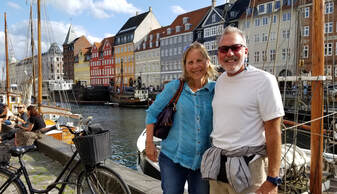 by Marcia Simon, APR, CTA Copenhagen is a fabulous walking city. Tip #1: Do NOT walk in the bike lanes. Unlike the United States, where cyclists are often forced to share roads with motor vehicles and pedestrians, bicycling in Denmark is a serious mode of transportation with designated lanes and traffic lights in urban areas. In Copenhagen, where more than half of all employees bike to work, wandering tourists walking into bike lanes can lead to injury, so pay attention to the bike lanes and stay clear. The train and bus systems make it very easy to get around Copenhagen without a car. Whatever your mode of transportation, here are 7 things to do in Copenhagen:
Leading the Way for Sustainability Denmark is a world leader in bringing sustainability to life, affirming the importance of the United Nations’ Sustainable Development Goals. Currently, 30 percent of all Denmark’s energy comes from renewable sources, including bioenergy, followed by wind, solar and geothermal energy, according to the Ministry of Foreign Affairs in Denmark. The country’s public and private sectors are both committed to achieving an energy system without fossil fuels by 2050. The enthusiastic Danish Society of Engineers, IDA, and is ahead of schedule on the project, and has a roadmap to implement the goal of a 100 percent renewable energy system by 2035. Playing On a Heap of Trash One of the steps towards Copenhagen’s goal of becoming the world’s first carbon neutral capital includes the opening of Amager Bakke, or CopenHill, planned as the new epicenter for urban mountain sport, offering year-round skiing and snowboarding on artificial snow. It includes the world’s tallest artificial climbing wall, running and hiking trails, and a café – all surrounded by a sprawling recreation area with water sports, soccer fields, and even a go-kart track. The clincher? CopenHill is built on top of the city’s new waste management and energy plant. Amager Bakke is considered the most efficient waste-burning and energy-generating plant in the world, and is expected to power and heat 160,000 households across Copenhagen. Getting Away From the City As beautiful as Copenhagen is with its waterways and happy vibe, seeing the outlying countryside is part of the Danish experience. Whether you travel by bicycle, car, train or bus, here are 5 day-trips that take you outside Copenhagen’s city center:
Marcia Simon, APR, CTA, is a PRSA-accredited public relations practitioner, and an IATA-accredited travel advisor at FriendlyGroupTravel.com. Connect through facebook.com/friendlygrouptravel, Instagram @friendlygrouptravel or welcome@friendlygrouptravel.com 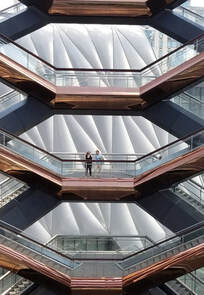 by Marcia Simon, CTA, APR You’ve got to love New York. Where else do they decide to build a new neighborhood and in couple of years come up with Hudson Yards, aptly named because it’s on the Hudson River overlooking the West Side Yard where Long Island Rail Road trains are stored between shuttles back and forth between “The Island” and Penn Station. The new neighborhood is billed as “a triumph of culture, commerce and cuisine – a place to live, work, and play.” Skyscrapers housing apartments, high-end retail shops, restaurants and a new luxury hotel are all in the works. Oh, they added a subway stop at Hudson Yards to accommodate the traffic. And if people aren’t flooding in yet to shop, visitors are surely interested in The Vessel. Contemporary urban designer Thomas Heatherwick created the bronzed steel and concrete Vessel just so people can climb the 2,500 steps of this 16-story recreational sculpture. It’s free to explore with a ticket you can get online or at one of the kiosks at Hudson Yards, although you may have to wait an hour or two for an available time since the number of people at one time is limited. There’s an elevator that makes the Vessel accessible for everyone. The Vessel is located at the north end of New York’s popular High Line, a public park built on a historic rail line above the city’s west side streets. It runs from 34th Street near the Javits Center to Gansevoort Street, three blocks south of 14th Street. Along the way you can have a seat on one of several benches, or stop for coffee, a smoothie, ice cream or other snacks. Kids seem to like The High Line as much as adults. For anyone who hasn’t walked the High Line recently, new “spurs” are being added as viewing areas and urban woodlands with a mix of grasses, perennial flowers and shrubs, all of which are native flora. Marcia Simon, APR, CTA, is a travel advisor, public relations practitioner and principal/owner of friendlygrouptravel.com. Connect through facebook.com/friendlygrouptravel or welcome@friendlygrouptravel.com. 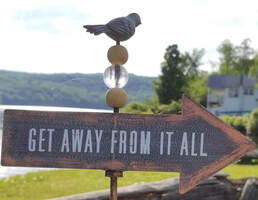 by Marcia Simon, APR, CTA We all feel, at times, the need to get away and shake up a monotonous routine. Planning that perfect escape can be daunting as the potential price tag adds up in your head, but recharging your inner batteries doesn’t have to take you geographically far away. It doesn’t need to take more than a day or two, and doesn’t need to cost a lot of money. Just one night away at a B&B gives you enough of a break to clear the garbles from your brain. Historic old homes lovingly turned into guest houses are scattered throughout New England, as an example, and getaways are surely within an easy three- or four-hour drive from your home, wherever you live. I recently visited The Fan House in Barnard, Vermont. It’s a little off the beaten path, far enough from the Interstate, and close enough for lots of day trip destinations, like Quechee, Vermont, known for its annual hot air balloon festival and Simon Pearce glass blowers, and Hanover, New Hampshire with a great college vibe and plenty of neat restaurants because of Dartmouth. Suicide Six ski area is only six miles away, while larger Killington and Okemo ski areas are about 45 minutes away and offer trail biking, hiking, golf and summer activities as well as some of the best winter skiing in the Northeast. On the way to the Fan House, I stopped at the Barnard General Store and indulged on a maple-cream-filled whoopie pie. After this I knew I was on a micro-vacation in Vermont. When I pulled into the Fan House driveway, Sara, the innkeeper, came out to greet me with her big friendly, shaggy dog Chappy, who neither jumped nor slobbered on me, but nuzzled up to my leg, wagged his tail and let me know I was welcome in his home. We walked around the yard and Sara showed me her country garden, filled with huge colorful poppies, foxglove, lupines, forget-me-nots and numerous other perennials that had not yet blossomed. The unmistakable fragrance of lilacs filled the air. I looked up to see a banner season for lilacs blooming along the property line by the main road. It was still a little shy of cocktail hour, but Sara joined me for a glass of wine in the living room area anyway. It was comfortable, relaxing and a pleasure talking candidly with someone who obviously had the gift for gab, was well traveled and has met her fair share of interesting characters along life’s enchanting journey. Just a couple of miles down the road, at the Barnard Inn restaurant, Max’s Tavern, a casual bistro, served up a cold crisp glass of pinot grigio to accompany a simple green salad tossed with maple Dijon vinaigrette and lightly topped with gorgonzola and candied walnuts. I must have needed my blue cheese fix, because my chosen entrée was house-made gnocchi with gorgonzola sauce, which was delicious with mild roasted cloves of garlic, caramelized onions and baby spinach. The first thought when I got ready for bed at the Fan House and realized there was no TV in my room was disappointment, but after about 10 seconds, I changed my mind. Being a news junkie and creature of habit who turns on the news before bedtime and upon wake-up, taking a break from the craziness was a blessing. In fact, it was a much-needed disconnect. The bed had eight pillows – two as bolsters, four for indulgent sleep and two more for decoration, which made a perfect spot to prop my laptop as I checked email before going to bed. The Wi-Fi worked well. I drifted into a deep sleep, woke up without an alarm, and went for a short walk to Barnard’s Silver Lake, sat on a bench and felt the early morning sun on my face, then continued walking – past lots of kayaks on racks and watched people come and go from the general store carrying cups of coffee to jumpstart their rural morning commutes. I read the bulletin board and learned about upcoming concerts, theater productions and youth summer programs at Barnard’s BarnArts.org. Having worked up an appetite for breakfast, which was included at my stay at the Fan House, I poured myself a cup of coffee and chatted it up with two guests visiting from Tennessee while Sara whipped up some blueberry pancakes and served them with warm maple syrup, along with fresh strawberries, granola and juice. At that moment, the pressures of the previous day’s workload were far from my mind. On the mid-morning car ride home I mentally prepared my “to do” list and the priorities seemed clear. I reminded myself to stay focused on those priorities and to let the other “urgencies” slide by if they weren’t aligned with my primary goals. I felt eager to tackle the workload, and not overwhelmed. One night away. To get unstuck. It’s well worth it. Marcia Simon, APR, CTA, is accredited as a travel advisor and public relations professional, and is principal/owner of friendlygrouptravel.com and MSE Public Relations. Visit www.friendlygrouptravel.com, www.facebook.com/friendlygrouptravel, friendgrouptravel on Instagram and FriendsGoTravel on Twitter, or email welcome@friendlygrouptravel.com. 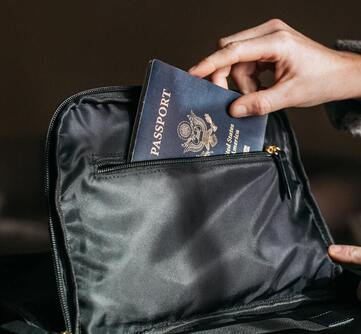 by Marcia Simon, APR, CTA Heading overseas for your next vacation or business trip? If you plan to use your phone – at all – for any reason – these tips and helpful apps will assure that your phone remains a valued and reliable companion when traveling internationally:
Marcia Simon, APR, CTA is a travel advisor and principal at friendlygrouptravel.com and MSE Public Relations. She writes about health, wellness and travel. Connect: welcome@friendlygrouptravel.com, facebook.com/friendlygrouptravel, @friendsgotravel on Twitter and friendgrouptravel on Instagram. |
AuthorMarcia Simon, CTA, APR, has been exploring new places since she was 17 years old and traveled around Europe on a Eurailpass with her best friend. Decades later, she still considers travel the best investment of time and money she's ever made for herself and her family. Categories
All
|
|
SIGN UP NOW FOR OUR NEWSLETTER WITH TRAVEL TIPS, IDEAS AND SPECIAL OFFERS
|

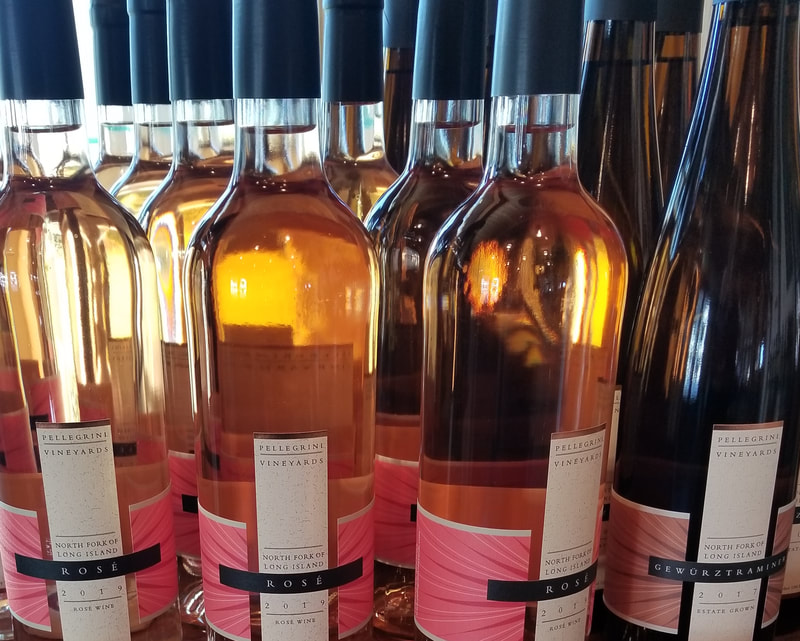
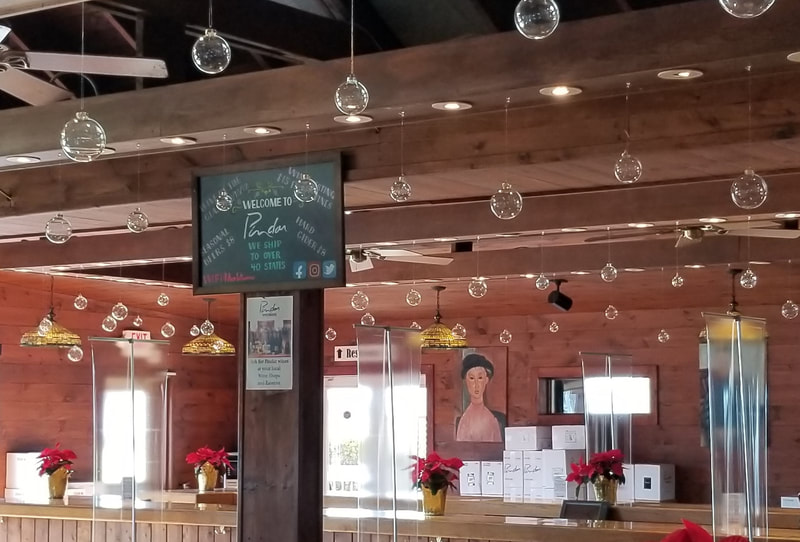
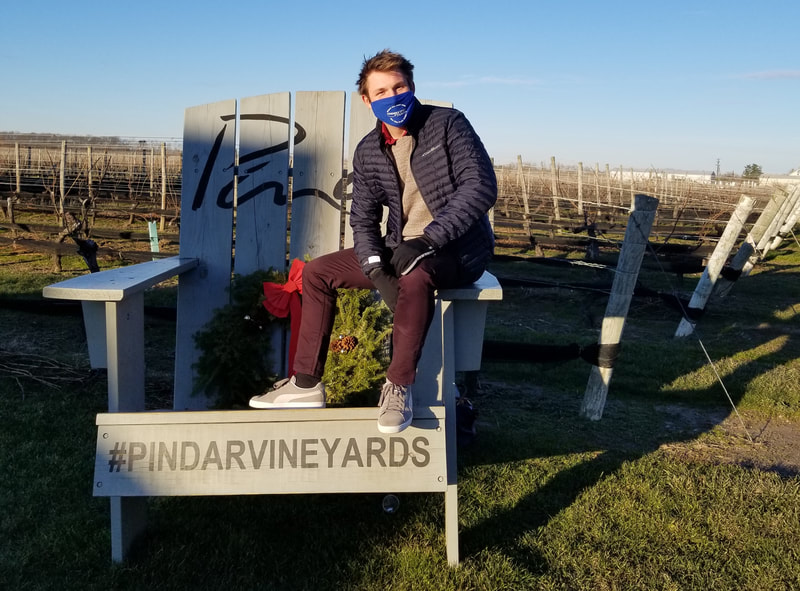
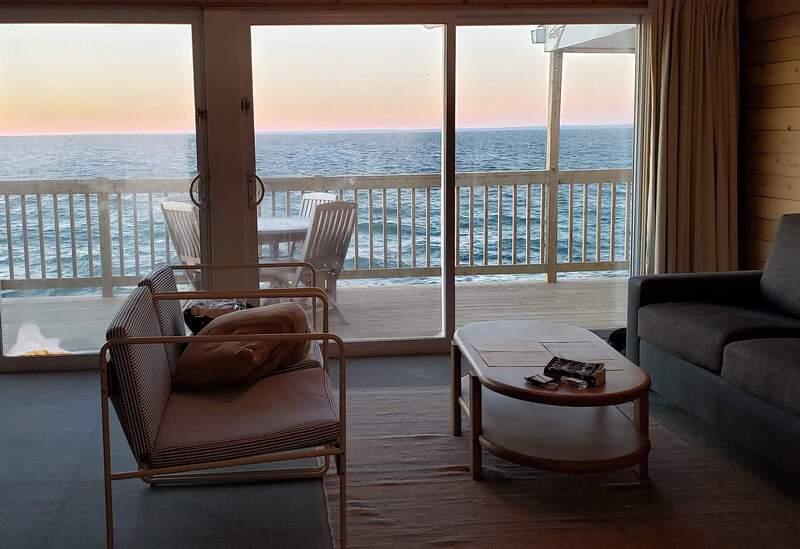

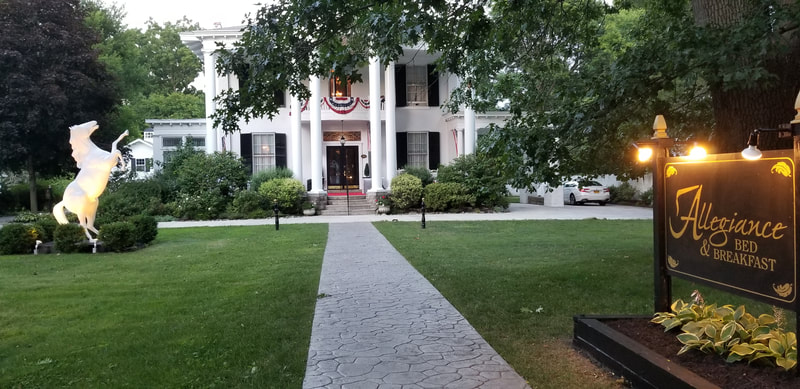
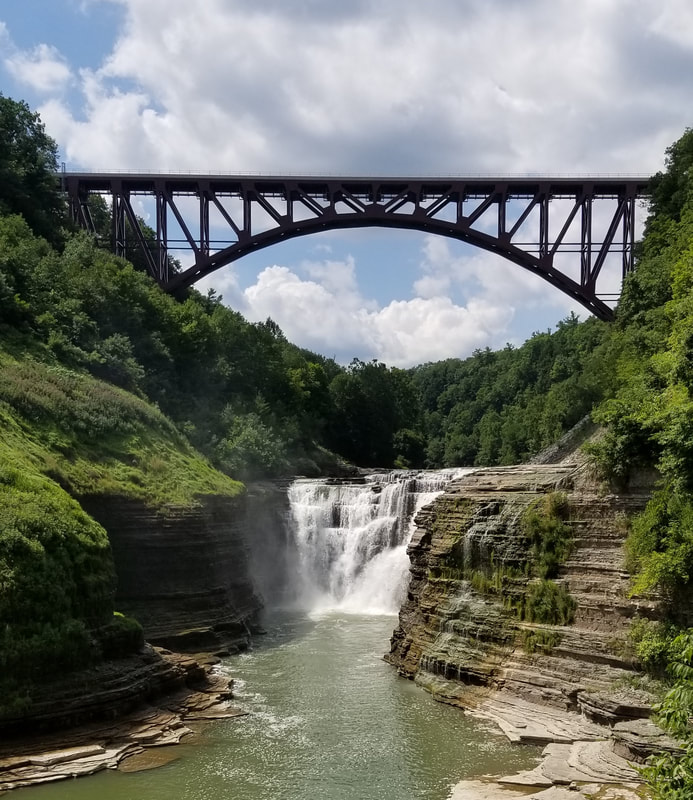

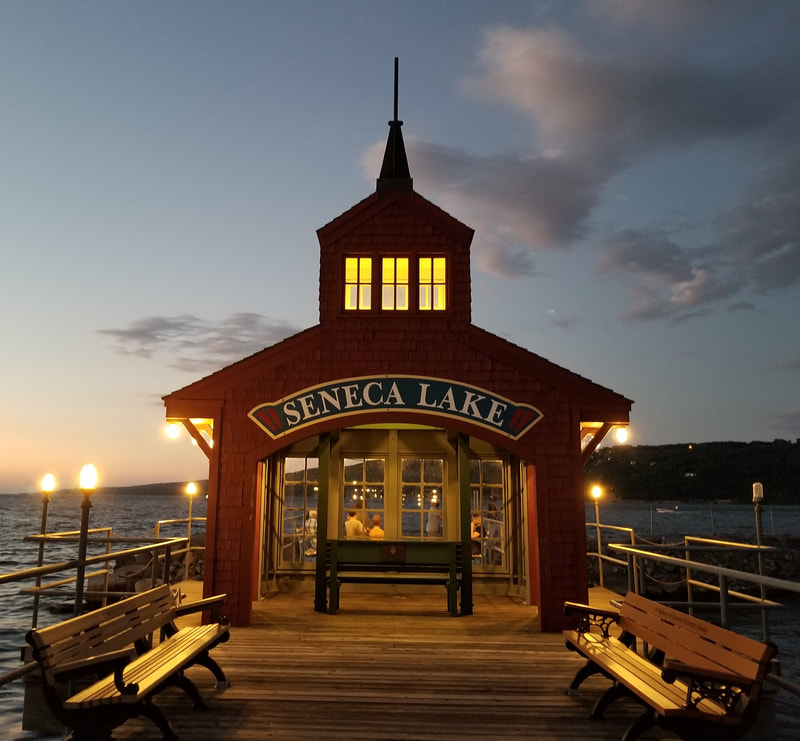
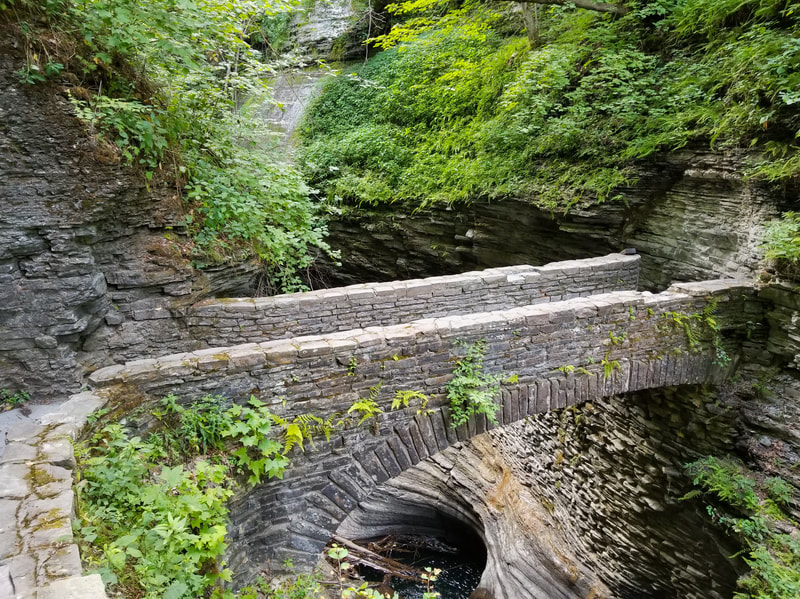
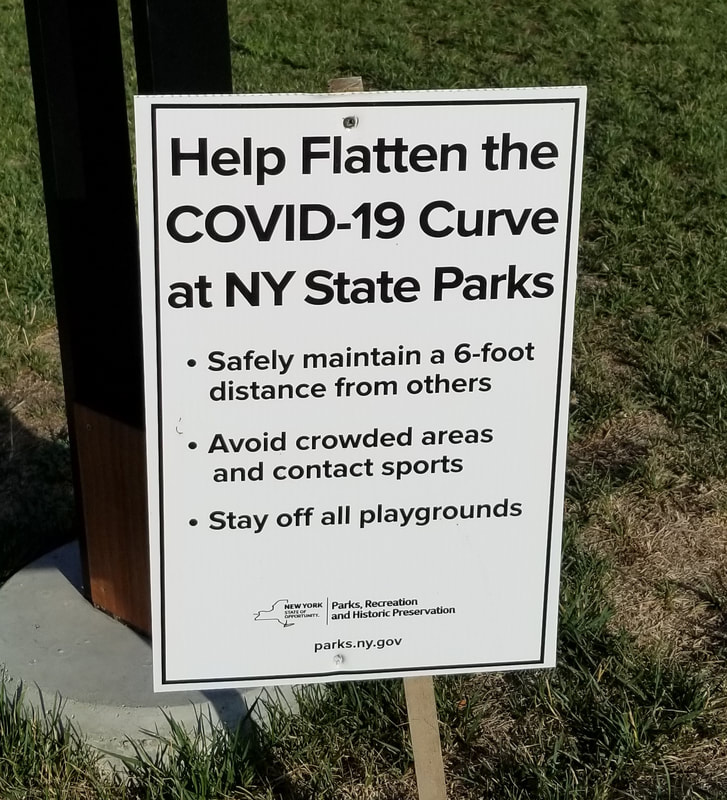

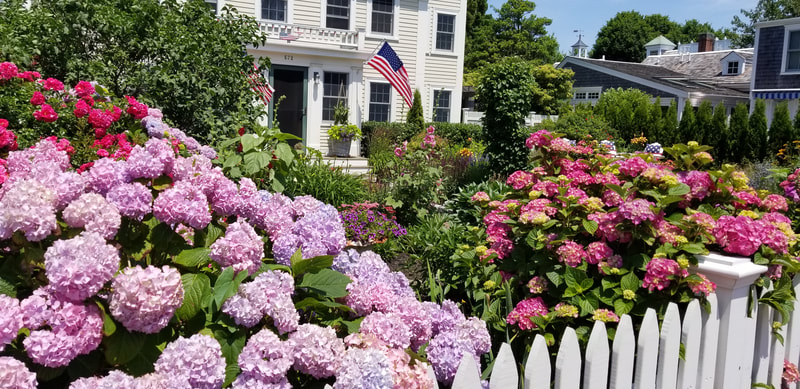
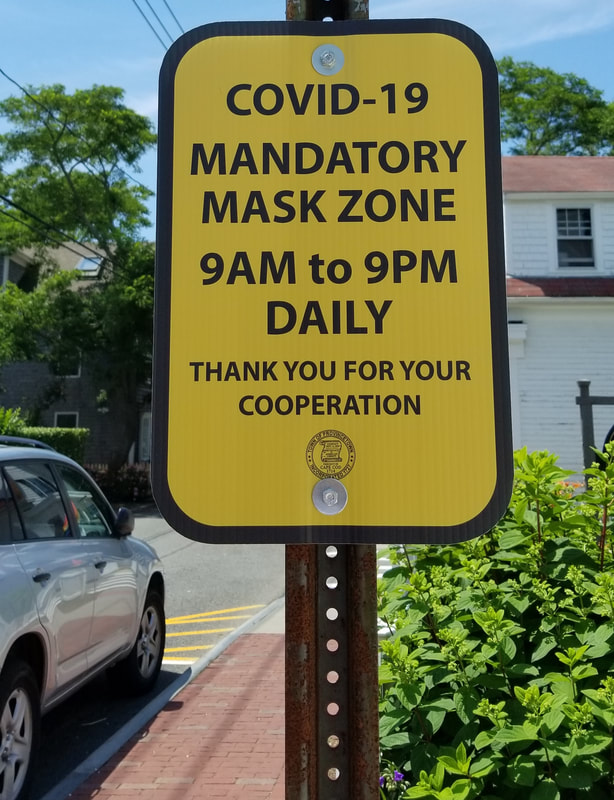
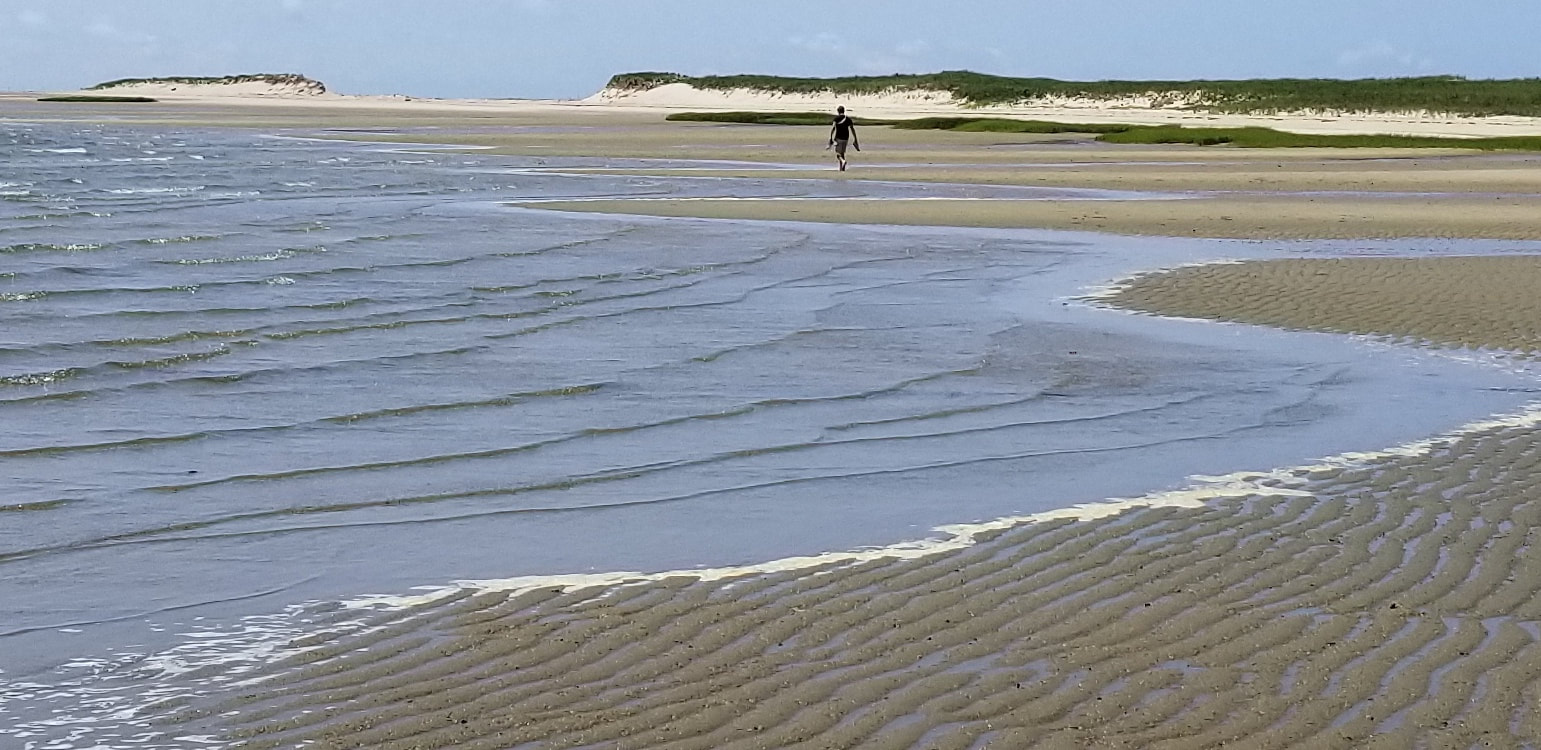
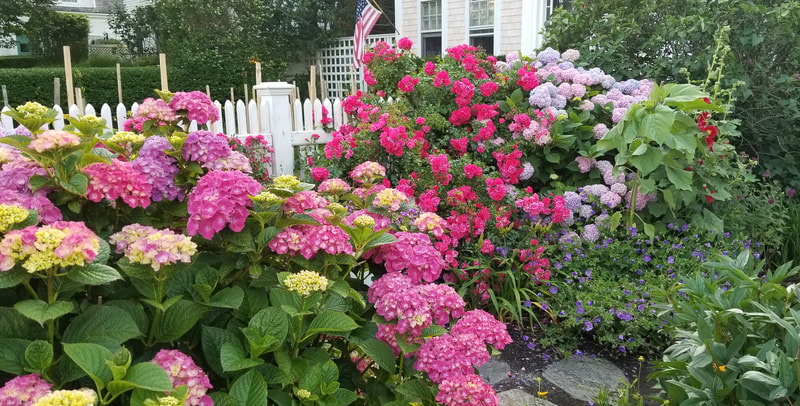

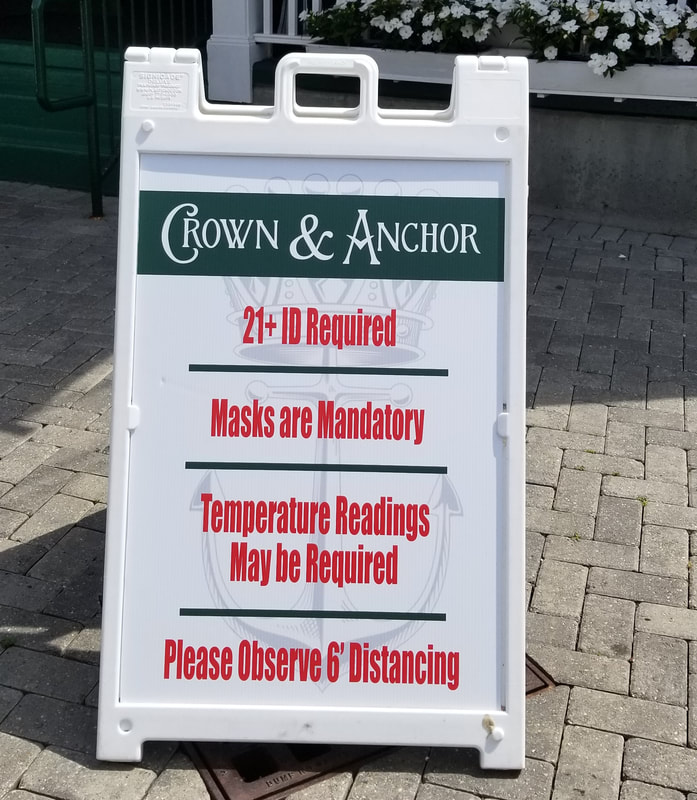
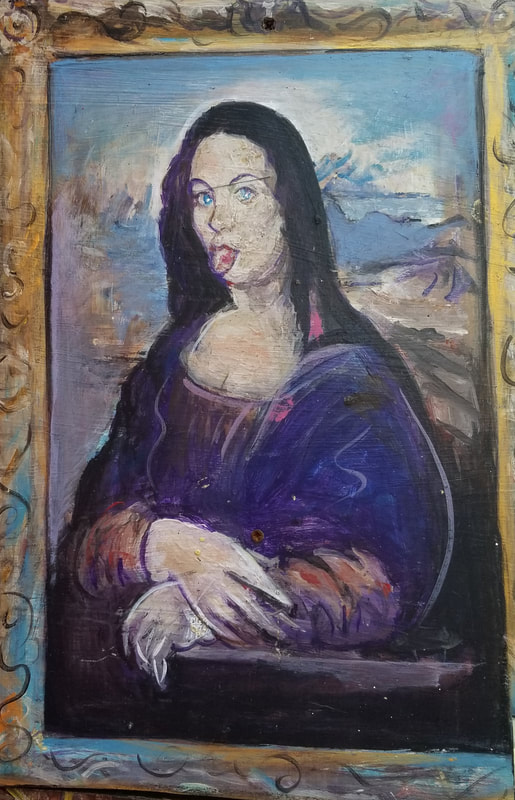

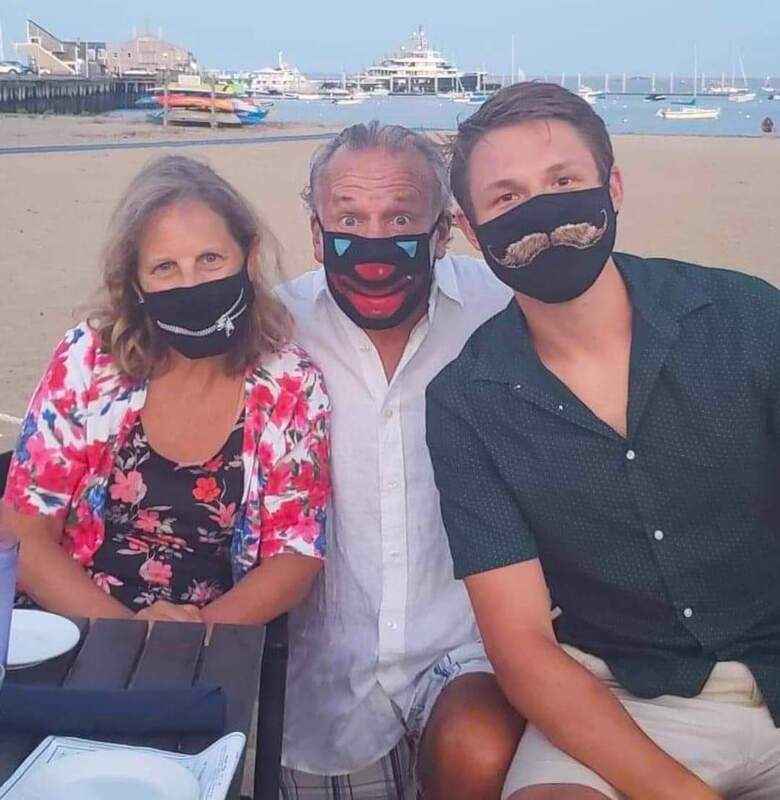
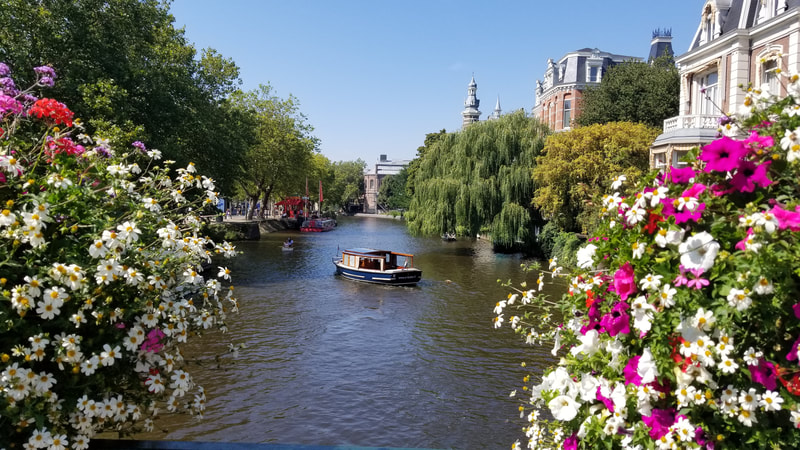
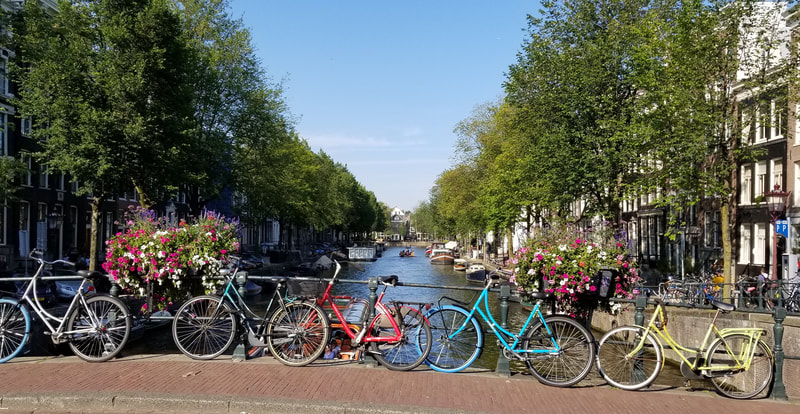
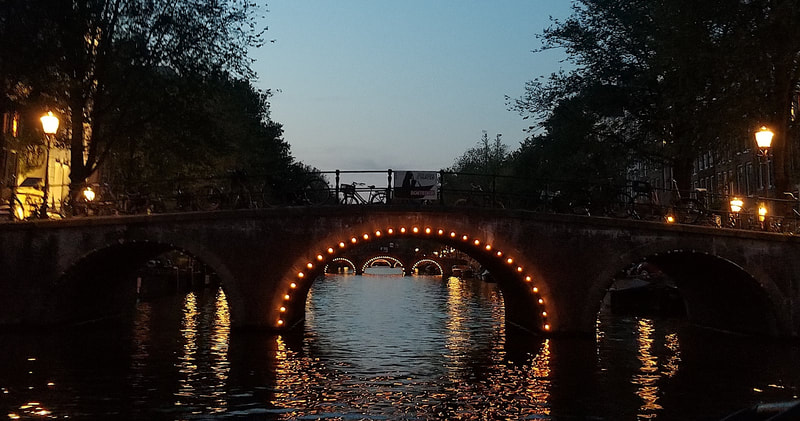
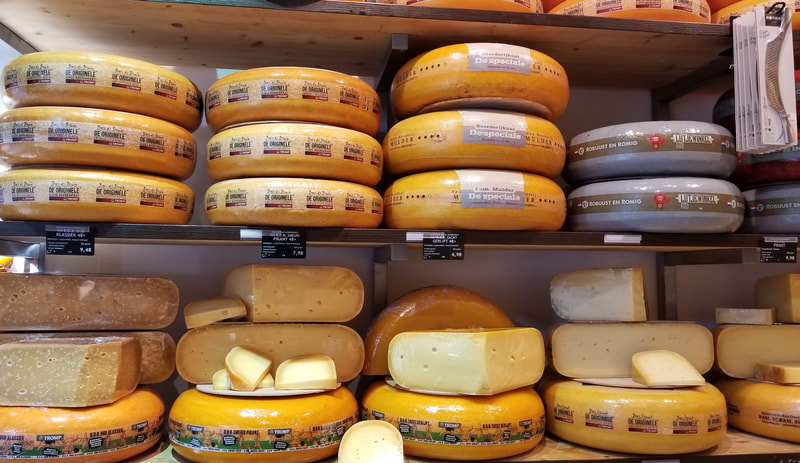
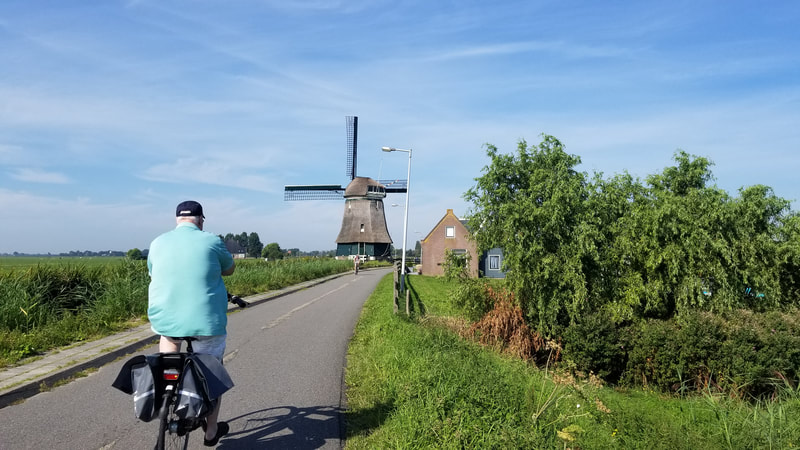
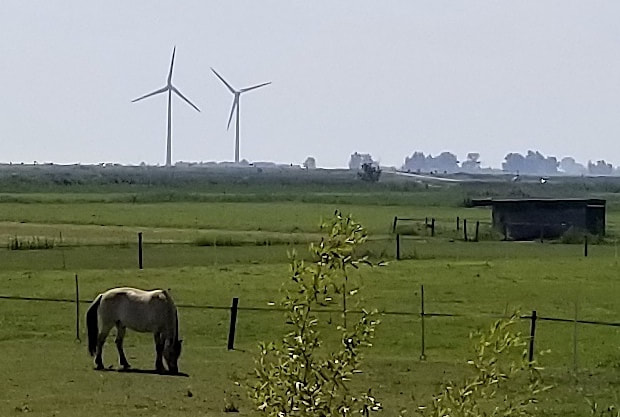
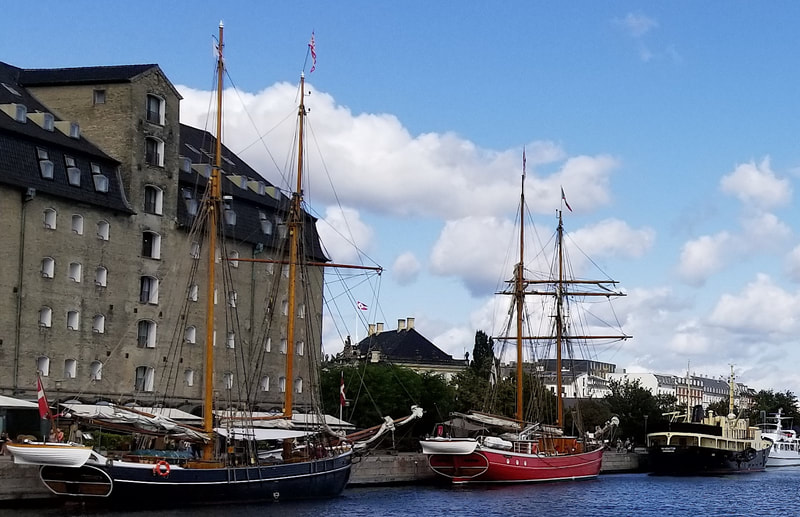
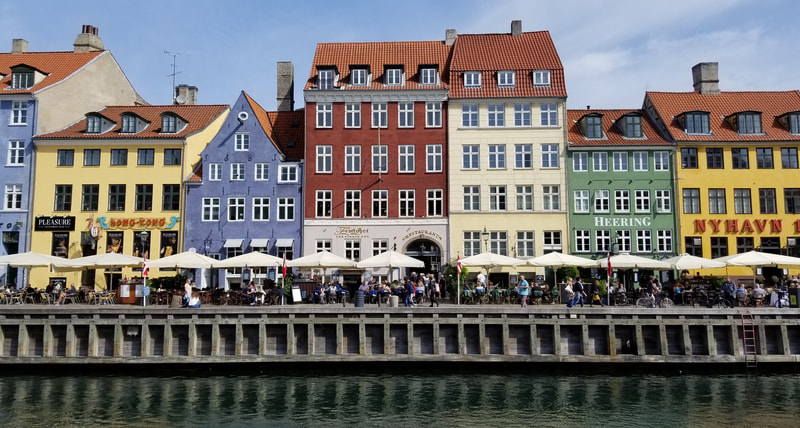
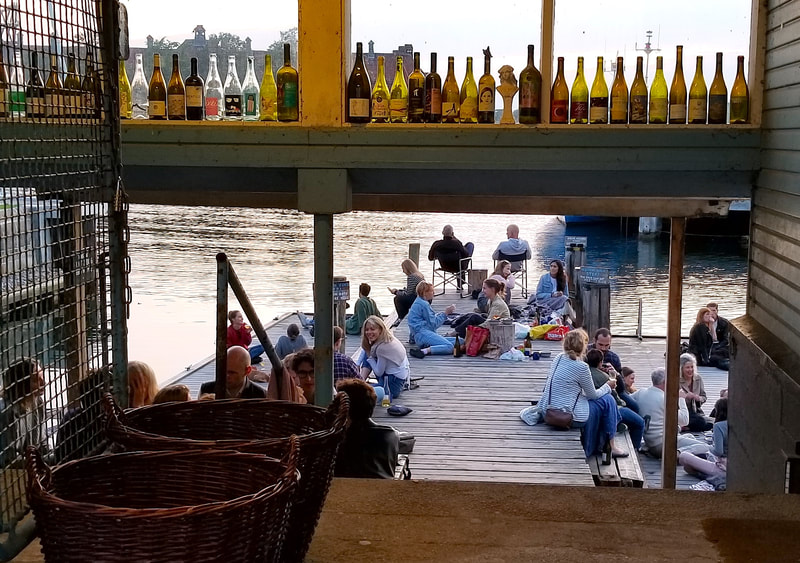



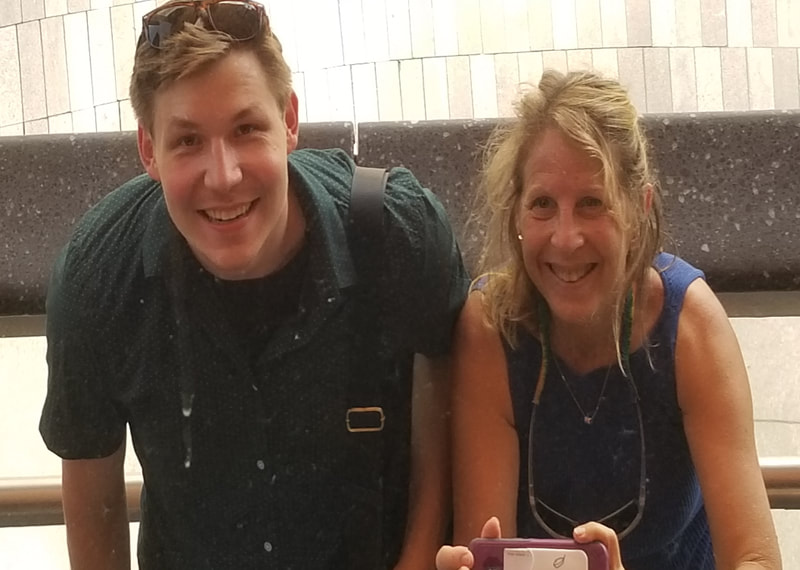




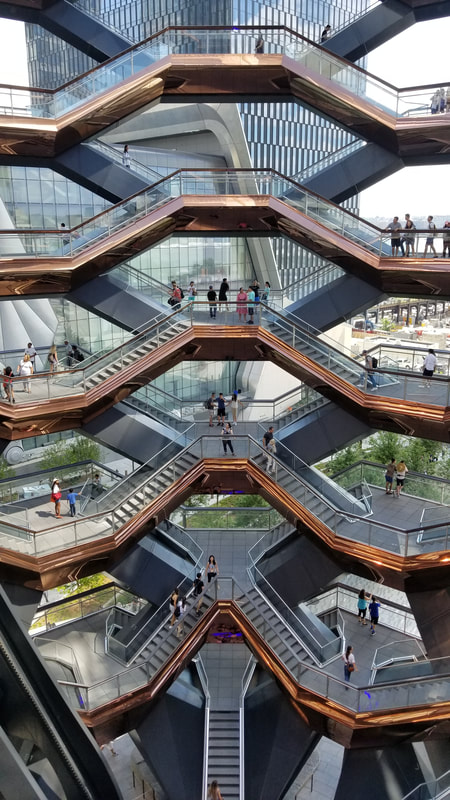
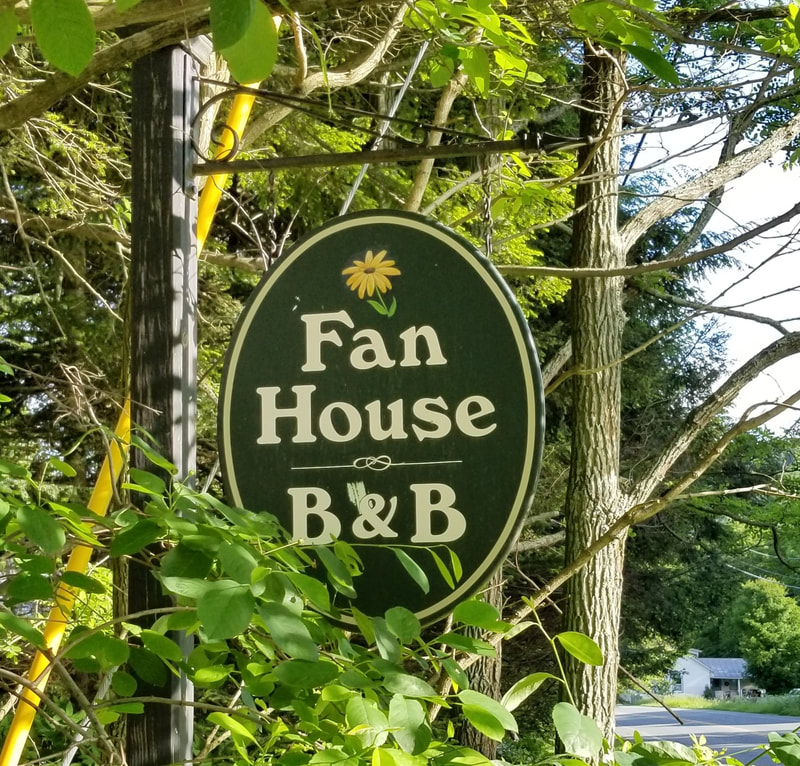
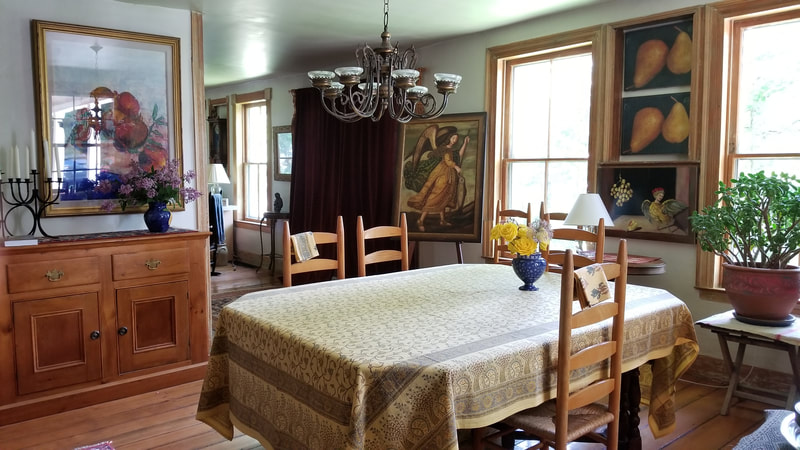
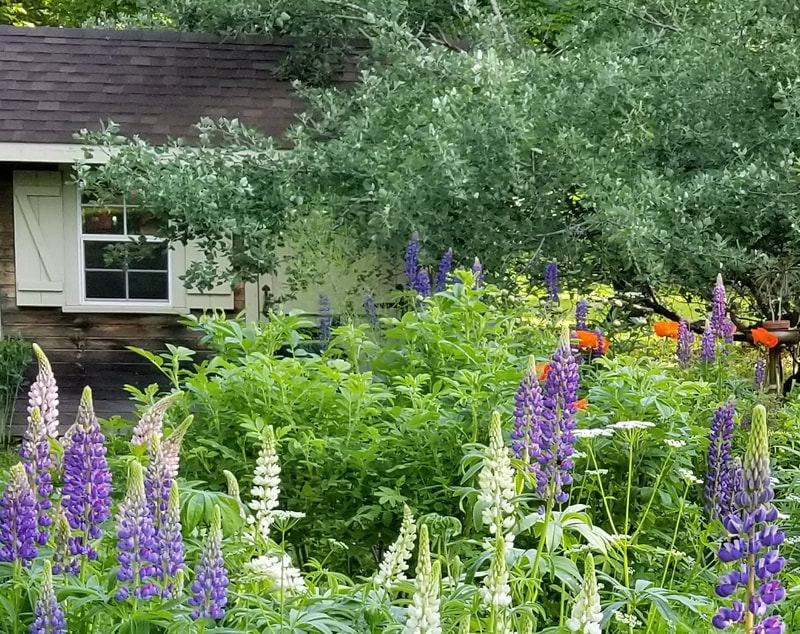
 RSS Feed
RSS Feed

